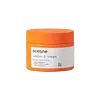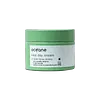What's inside
What's inside
 Key Ingredients
Key Ingredients

 Benefits
Benefits

 Concerns
Concerns

 Ingredients Side-by-side
Ingredients Side-by-side

Water
Skin ConditioningCoco-Caprylate/Caprate
EmollientC10-18 Triglycerides
EmollientDimethicone
EmollientHydrogenated Polyisobutene
EmollientAluminum Starch Octenylsuccinate
AbsorbentCetyl Alcohol
EmollientGlyceryl Stearate
EmollientNiacinamide
SmoothingMethylpropanediol
SolventAscorbic Acid
AntioxidantSodium Hyaluronate
HumectantHydrolyzed Hyaluronic Acid
HumectantSodium Acetylated Hyaluronate
HumectantMelaleuca Alternifolia Leaf Extract
PerfumingCeramide NP
Skin ConditioningCholesterol
EmollientStearic Acid
CleansingCaprylic/Capric Triglyceride
MaskingPhytosphingosine
Skin ConditioningOleic Acid
EmollientLactic Acid
BufferingHydrogenated Lecithin
EmulsifyingSorbitan Isostearate
EmulsifyingPolysorbate 60
EmulsifyingHydroxyethyl Acrylate/Sodium Acryloyldimethyl Taurate Copolymer
Emulsion StabilisingPEG-75 Stearate
Ceteth-20
CleansingSteareth-20
CleansingDimethiconol
EmollientCarrageenan
Sucrose
HumectantBetaine
HumectantAllantoin
Skin ConditioningTromethamine
Buffering1,2-Hexanediol
Skin ConditioningHydroxyacetophenone
AntioxidantCI 19140
Cosmetic ColorantWater, Coco-Caprylate/Caprate, C10-18 Triglycerides, Dimethicone, Hydrogenated Polyisobutene, Aluminum Starch Octenylsuccinate, Cetyl Alcohol, Glyceryl Stearate, Niacinamide, Methylpropanediol, Ascorbic Acid, Sodium Hyaluronate, Hydrolyzed Hyaluronic Acid, Sodium Acetylated Hyaluronate, Melaleuca Alternifolia Leaf Extract, Ceramide NP, Cholesterol, Stearic Acid, Caprylic/Capric Triglyceride, Phytosphingosine, Oleic Acid, Lactic Acid, Hydrogenated Lecithin, Sorbitan Isostearate, Polysorbate 60, Hydroxyethyl Acrylate/Sodium Acryloyldimethyl Taurate Copolymer, PEG-75 Stearate, Ceteth-20, Steareth-20, Dimethiconol, Carrageenan, Sucrose, Betaine, Allantoin, Tromethamine, 1,2-Hexanediol, Hydroxyacetophenone, CI 19140
Glycerin
HumectantPhenyl Trimethicone
Skin ConditioningCaprylic/Capric Triglyceride
MaskingButylene Glycol
HumectantNeopentyl Glycol Diheptanoate
EmollientOlea Europaea Fruit Oil
MaskingNiacinamide
SmoothingBetaine
HumectantArachidyl Alcohol
EmollientDiisostearyl Malate
EmollientCentella Asiatica Extract
CleansingHydrogenated Phosphatidylcholine
EmulsifyingAsiaticoside
AntioxidantMadecassic Acid
Skin ConditioningAsiatic Acid
Skin ConditioningSucrose Stearate
EmollientMadecassoside
AntioxidantCholesterol
EmollientCeramide NP
Skin ConditioningDipropylene Glycol
HumectantGlycol Stearate Se
EmulsifyingCetearyl Alcohol
EmollientStearic Acid
CleansingHydrogenated Lecithin
EmulsifyingBehenyl Alcohol
EmollientArachidyl Glucoside
EmulsifyingDimethicone/Vinyl Dimethicone Crosspolymer
Skin ConditioningPolyacrylate-13
Polyisobutene
Polysorbate 20
EmulsifyingSorbitan Isostearate
EmulsifyingGlyceryl Stearate
EmollientPEG-100 Stearate
Panthenol
Skin ConditioningGlycosyl Trehalose
Emulsion StabilisingHydrogenated Starch Hydrolysate
HumectantXanthan Gum
EmulsifyingAllantoin
Skin ConditioningAdenosine
Skin ConditioningDisodium EDTA
1,2-Hexanediol
Skin ConditioningHydroxyacetophenone
AntioxidantParfum
MaskingAlpha-Isomethyl Ionone
PerfumingCitronellol
PerfumingHydroxycitronellal
PerfumingLinalool
PerfumingGlycerin, Phenyl Trimethicone, Caprylic/Capric Triglyceride, Butylene Glycol, Neopentyl Glycol Diheptanoate, Olea Europaea Fruit Oil, Niacinamide, Betaine, Arachidyl Alcohol, Diisostearyl Malate, Centella Asiatica Extract, Hydrogenated Phosphatidylcholine, Asiaticoside, Madecassic Acid, Asiatic Acid, Sucrose Stearate, Madecassoside, Cholesterol, Ceramide NP, Dipropylene Glycol, Glycol Stearate Se, Cetearyl Alcohol, Stearic Acid, Hydrogenated Lecithin, Behenyl Alcohol, Arachidyl Glucoside, Dimethicone/Vinyl Dimethicone Crosspolymer, Polyacrylate-13, Polyisobutene, Polysorbate 20, Sorbitan Isostearate, Glyceryl Stearate, PEG-100 Stearate, Panthenol, Glycosyl Trehalose, Hydrogenated Starch Hydrolysate, Xanthan Gum, Allantoin, Adenosine, Disodium EDTA, 1,2-Hexanediol, Hydroxyacetophenone, Parfum, Alpha-Isomethyl Ionone, Citronellol, Hydroxycitronellal, Linalool
Ingredients Explained
These ingredients are found in both products.
Ingredients higher up in an ingredient list are typically present in a larger amount.
1,2-Hexanediol is a synthetic liquid and another multi-functional powerhouse.
It is a:
- Humectant, drawing moisture into the skin
- Emollient, helping to soften skin
- Solvent, dispersing and stabilizing formulas
- Preservative booster, enhancing the antimicrobial activity of other preservatives
Allantoin is a soothing ingredient known for its protective and moisturizingg properties. Because of this, it is often added to products with strong active ingredients.
Studies show higher concentrations of this ingredient can promote wound healing.
Though it can be derived from the comfrey plant, allantoin is produced synthetically for cosmetic products to ensure purity.
Learn more about AllantoinBetaine is a common humectant (a substance that promotes retention of moisture). It's known to be gentle on the skin and can help balance hydration.
This ingredient is best for improving hydration and soothing irritated skin. Studies also show it helps even out skin tone.
Fun fact: Betaine is naturally created in the skin and body. The kind found within cosmetic products can be either plant-derived or synthetic.
Another name for betaine is trimethylglycine.
Learn more about BetaineThis ingredient is an emollient, solvent, and texture enhancer. It is considered a skin-softener by helping the skin prevent moisture loss.
It helps thicken a product's formula and makes it easier to spread by dissolving clumping compounds.
Caprylic Triglyceride is made by combining glycerin with coconut oil, forming a clear liquid.
While there is an assumption Caprylic Triglyceride can clog pores due to it being derived from coconut oil, there is no research supporting this.
Learn more about Caprylic/Capric TriglycerideCeramide NP is a type of ceramide and formally known as ceramide 3.
Ceramides are intercellular lipids naturally found in our skin that bonds dead skin cells together to create a barrier. They are known for their ability to hold water and thus are a great ingredient for dry skin.
Ceramides are an important building block for our skin barrier. A stronger barrier helps the skin look more firm and hydrated. By bolstering the skin ceramides act as a barrier against irritating ingredients. This can help with inflammation as well.
If you would like to eat ceramides, sweet potatoes contain a small amount.
Read more about other common types of ceramides here:
Ceramide AP
Ceramide EOP
Cholesterol is a class of organic molecules called lipids. It helps hydrate your skin and is essential to having a healthy skin barrier.
Our skin naturally contains cholesterol in the outermost layer. Besides cholesterol, it also contains ceramides and fatty acids. Cholesterol makes up about 1/4 of your skin's outer layer and barrier. Your skin barrier is responsible for keeping allergens and microbes out. Having a healthy skin barrier is also responsible for keeping your skin firm and plump.
Our bodies use cholestrol to create vitamin D, steroid hormones, and more.
Learn more about CholesterolGlyceryl Stearate is a mix of glycerin and stearic acid.
It is used to stabilize the mixing of water and oil ingredients. By preventing these ingredients from separating, it can help elongate shelf life. It can also help thicken the product's texture.
As an emollient, it helps soften skin and supports barrier-replenishing ingredients.
In cosmetics, Glyceryl Stearate is often made from vegetable oils or synthetically produced.
This ingredient may not be fungal-acne safe
Fun fact: The human body also creates Glyceryl Stearate naturally.
Learn more about Glyceryl StearateHydrogenated Lecithin is created from the hydrogenation of lecithin (a group of phospholipids). Hydrogenation is a chemical reaction between hydrogen and another element.
This ingredient is an emollient and emulsifier. As an emollient, it helps soften skin by trapping moisture within. As an emulsifier, it prevents oil and water ingredients from separating.
Hydroxyacetophenone is antioxidant with skin conditioning and soothing properties. It also boosts the efficiency of preservatives.
This ingredient is not irritating or sensitizing.
Niacinamide is a multitasking form of vitamin B3 that strengthens the skin barrier, reduces pores and dark spots, regulates oil, and improves signs of aging.
And the best part? It's gentle and well-tolerated by most skin types, including sensitive and reactive skin.
You might have heard of "niacin flush", or the reddening of skin that causes itchiness. Niacinamide has not been found to cause this.
In very rare cases, some individuals may not be able to tolerate niacinamide at all or experience an allergic reaction to it.
If you are experiencing flaking, irritation, and dryness with this ingredient, be sure to double check all your products as this ingredient can be found in all categories of skincare.
When incorporating niacinamide into your routine, look out for concentration amounts. Typically, 5% niacinamide provides benefits such as fading dark spots. However, if you have sensitive skin, it is better to begin with a smaller concentration.
When you apply niacinamide to your skin, your body converts it into nicotinamide adenine dinucleotide (NAD). NAD is an essential coenzyme that is already found in your cells as "fuel" and powers countless biological processes.
In your skin, NAD helps repair cell damage, produce new healthy cells, support collagen production, strengthen the skin barrier, and fight environmental stressors (like UV and pollution).
Our natural NAD levels start to decline with age, leading to slower skin repair, visible aging, and a weaker skin barrier. By providing your skin niacinamide, you're recharging your skin's NAD levels. This leads to stronger, healthier, and younger looking skin.
Another name for vitamin B3 is nicotinamide. This vitamin is water-soluble and our bodies don't store it. We obtain Vitamin B3 from either food or skincare. Meat, fish, wheat, yeast, and leafy greens contain vitamin B3.
The type of niacinamide used in skincare is synthetically created.
Learn more about NiacinamideSorbitan Isostearate is an emulsifer and cleaning agent. It is created from isostearic acid and sorbitol.
As an emulsifier, Sorbitan Isostearate prevents oils and water from separating.
Due to its isostearic acid base, it may not be safe for Malassezia or fungal acne.
Learn more about Sorbitan IsostearateStearic Acid is a fatty acid. It is an emollient, emulsifier, and texture enhancer.
As an emollient, stearic acid helps soften skin. It aids the skin's protective barrier by preventing water loss. It also provides a gentle cleansing effect without stripping away natural oils.
Stearic acid may also be used to enhance the texture of products. It can add volume and stabilize ingredients such as water and oil. This can help water and oil ingredients from separating.
Sources of stearic acid include animal or vegetable fats/oils such as coconut or shea. It can be naturally found in butter, cocoa butter, shea butter, vegetable fats, and animal tallow.
This ingredient may not be Malassezia folliculitis, or fungal-acne safe.
Learn more about Stearic Acid